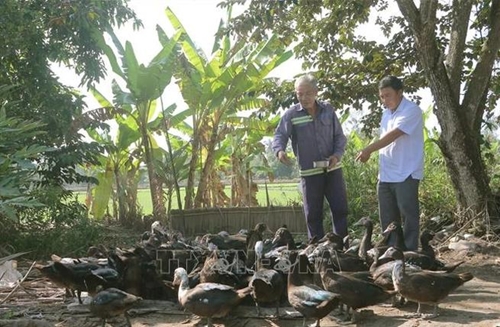Soc Trang is home to nearly 1.2 million people, about 35% of whom are from ethnic minority groups. It has the highest rate of Khmer people in Vietnam, with over 30% of the local population or about 362,000 people.
In My Tu district, Khmer people number 32,253 from 7,482 households, making up 24.59% of its population, mainly in Phu My, My Thuan, and Thuan Hung districts.
    |
 |
|
A Khmer ethnic household in Nga Nam township, Soc Trang province, has received a concessional loan to develop duck farming. |
Le Thanh Vi, Vice Secretary of the Party Committee of My Tu district, said the committee has paid consistent attention to guiding the implementation of the policies targeting ethnic minority groups, including Khmer.
Since 2019, the district has provided vocational training for 2,113 Khmer people and jobs for 4,692. Meanwhile, 4,696 Khmer households have accessed concessional loans to develop livelihoods.
Vi noted annual per capita income of Khmer people has reached 63 million VND (over 2,500 USD), helping bring the household poverty rate in the Khmer community here down to 0.96%.
Danh Chum, a Khmer resident in Thuan Hung commune of My Tu district, said that three years ago, his family could not make ends meet. In 2022, his family was assisted by the local administration to build a new house, purchase cows to farm, and engage in small trading, thus gradually improving their living conditions.
Chau Thi Muoi, Chairwoman of the People’s Committee of Thuan Hung commune in My Tu district, said as poverty alleviation in ethnic minority areas is identified as a crucial task, local authorities have undertaken comprehensive measures to reduce poverty. In particular, communications have been boosted on the sustainable poverty reduction program and new vegetable crops and animal husbandry introduced to the region, including cattle and deer farming.
Meanwhile, Nga Nam township has stepped up short-term vocational training and job creation for ethnic minority people to improve their income.
Huynh Van Lo, head of the Labor, Invalids and Social Affairs Division of Nga Nam, noted various poverty reduction measures have been adopted and proved effective, with vocational training and job creation among important solutions.
Each year, more than 400 households in the township successfully escape from poverty while nearly 500 others get rid of the near-poor status. The household poverty rate has declined by 2% annually, down to 1.4% in total, and by 4% among Khmer households, he elaborated.
Danh Son, a resident in Vinh Quoi commune of Nga Nam, shared that previously, his family did not own farmland and lived under the poverty line. Since enrolling in a short-term training course on weaving water hyacinth to create handicrafts, life has improved, and his family managed to make a better living in late 2023.
Son added that in recent years, the craft of weaving water hyacinth has become an additional source of income for local Khmer people, generating 4 - 5 million VND (160 - 200 USD) per capita each month.
Thanks to assistance from the national target programs on socioeconomic development in ethnic minority and mountainous areas, stable outcomes include sustainable poverty reduction and new-style countryside building. Many structures have been built to improve transport infrastructure and support agricultural production, creating favorable conditions for locals to trade goods and stabilize livelihoods and contributing to sustainable poverty alleviation.
Chairman of the Soc Trang People’s Committee Tran Van Lau highlighted the progress in poverty reduction in the province thanks to the active implementation of different measures. As of the end of 2023, the number of impoverished households decreased to 8,521, down 2% annually. The rate of poor households in the Khmer community fell by 3% annually down to 4%.
Local authorities have been capitalizing on support from central agencies and also mobilizing different resources to assist ethnic minority people, particularly Khmer, to develop livelihoods and sustainably alleviate poverty.
Lau added that in the coming time, the provincial administration will boost combining socioeconomic development policies, programs, and projects, especially the three national target programs, to gradually upgrade infrastructure in ethnic minority areas, thus facilitating income improvement.
Source: VNA